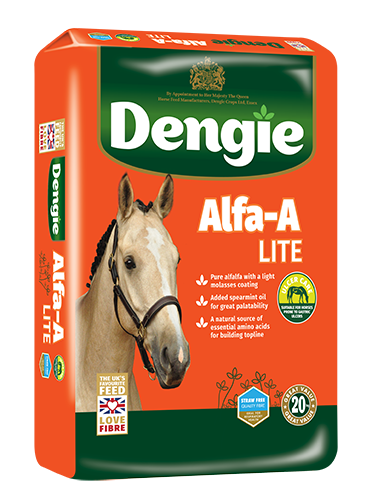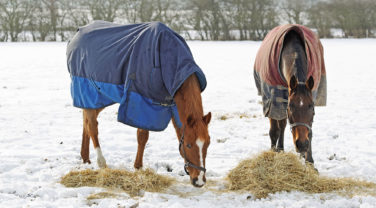Feeding your Stallion
If you’ve made the decision to stand a stallion at stud, your success will largely be determined by your stallion’s fertility. Because diet is thought to have an impact on fertility and reproductive performance, paying careful attention to what your stallion is consuming could pay dividends.
Energy requirements of your stallion
Just as for all horses and ponies, the individual stallion’s energy requirements will vary according to a number of factors, including breed and temperament. It is suggested that stallions generally have a greater energy requirement than mares or geldings with the same characteristics, probably about 10% more for maintenance in the non-breeding season.
Once the stallion starts covering, his energy requirements will largely be determined by how many covers he carries out, whether for mares or for collection for artificial insemination. Covering 12 times a week would be considered as hard work and would have an increased energy requirement of about 20% over maintenance requirements.
A balanced diet is vital for your Stallion’s good health and fertility
Because a balanced diet is vital for good health and fertility, stallions that are overweight or good doers should be fed low-calorie sources of vitamins and minerals, such as balancers or supplements.
Nutrition and fertility in horses
Relatively little work has been done with horses in relation to the effects of diet on fertility, so most of the information available comes from other species.
Fatty acids are found in cell membranes and studies have shown that essential fatty acids are present in semen in much larger quantities than other mammalian tissues. In other species, it is commonplace to feed additional omega-3 fatty acids to try to improve fertility, particularly where semen is being chilled or frozen, because more robust cell membranes enable the sperm to withstand better the rigours of chilling, freezing and thawing.
Although the horse wouldn’t consume high levels of oil naturally because grass is very low in oil, the oil it does contain has higher levels of omega-3 than 6, so the horse’s overall diet would have a higher omega-3 content than omega-6. As omega-6 effectively competes with omega-3, high omega-6 intakes can be detrimental to the horse. Cereals are higher in omega-6 than 3, so the more cereals that are used in the ration, the more supplementary omega-3 becomes important.
The best sources of omega-3 are fish oil because this contains EPA and DHA, which are in the form that the animal needs them. For those who prefer not to feed fish oil, hemp oil is the next best option because it contains stearidonic acid, which requires fewer steps to convert it to EPA than omega-3 from other sources, such as linseed and soya.
Zinc is a trace mineral commonly recognised as being important for fertility because it is a key constituent of testosterone. Interestingly, stallions’ requirements for zinc are no different whether covering or not, which suggests that, as with most nutrients, providing enough is crucial, but feeding extra might have no beneficial effect.
A study in 2005 on human males showed that increasing levels of the antioxidant Vitamins E and C and beta carotene resulted in higher sperm numbers and motility. Beta carotene is a pre-cursor of Vitamin A but is now known to be beneficial in its own right. There have been many studies in dairy cattle looking at the effect of beta carotene on female fertility, but less work done in equines either male or female.
The main sources of beta carotene in a horse’s diet are green, leafy plants, so the horse at grass should be consuming plenty of beta carotene. The stabled stallion however, being fed older or poorer-quality forage, might be consuming considerably less. Adding alfalfa to the ration would provide lots of beta carotene, as illustrated by its dark green colour.
Vitamin E is regularly included in feeds, supplements and balancers by manufacturers, so using the recommended amount of one of these should be sufficient for most stallions. However, Vitamin C is not routinely added and, because the horse’s requirements tend to increase at times of stress, sourcing a feed that does contain supplementary Vitamin C might prove beneficial in relation to fertility.
Practical considerations when feeding your Stallion
An intensive covering programme can have many effects on a stallion’s behaviour and a fairly common reaction is for them to go off their feed. This can obviously have an impact on the weight of the stallion but, over a prolonged period, could potentially affect fertility because essential nutrients are missing from the diet. Sperm take 60 days to develop, so the effects on fertility might become apparent only much later.
In these situations, very concentrated feeds such as balancers might be useful because they supply the essential nutrients needed for health in a small volume of feed. Tempting stallions with tasty feeds such as Alfa-A Molasses Free or Healthy Tummy, which contain herbs including fenugreek and oregano, might encourage them to eat up.
For stallions that are prone to being over-excitable or difficult to handle, it is advisable to use feeds that contain low levels of starch and sugar, which are more likely to result in or exacerbate feisty behaviour. Fibre and oil are both slow-release energy sources and feeds such as Alfa-A Oil that combine the two have an energy value equivalent to a conditioning or stud mix. Therefore, it is possible to supply enough energy in a slow-release form.



